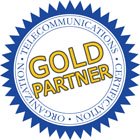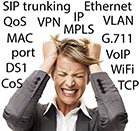This article previously appeared in the free monthly Teracom newsletter. subscribe
We could simplify "telecommunications" by claiming that there are two kinds of traffic or information to be communicated: information that happens in continuous streams, and information that happens in bursts.
Video is a good example of information that happens in continuous streams: when sending video to someone, we are constantly transmitting picture information. E-mail is a good example of information that happens in bursts: you send e-mail to someone, and then you don't.
Telecommunication service providers like Verizon, AT&T, Bell Canada, TELUS and Sprint have two basic kinds of services: they have services that allow their customers to transmit continuous streams of information; and services that allow their customers to transmit bursts of information.
If we look one level deeper in the network, to see how these services are offered, we find that the way that a service provider offers to its customers the possibility of communicating information in bursts is to take a circuit that actually communicates in continuous streams, attach boxes called routers or ATM switches to each end, connect a large number of customers and let them send information whenever there's a free spot on the circuit that communicates all the time.
Now you know everything there is to know about telecommunications. Not. We're not going to simplify things quite that much, but… once you achieve spiritual nirvana in telecommunications, you will realize that all of the services you hear about like T1, ISDN, Frame Relay, Internet access and the rest are all really billing plans.
There is really only one kind of transmission circuit - fiber optic transmission circuits using SONET technology in days past and Optical Ethernet for new installations. There are a few methods of providing access to these fiber transmission systems: copper wires, radio and fiber. There are many, many ways of billing you for using some of the capacity on the transmission system in different ways and at different times.
It's not like there is one "fiber backbone" for voice, a different one for data, a third one for television and a fourth one for the Internet. It all runs over the same pieces of glass with the same light flashing on and off to represent 1s and 0s.
This, along with Answer #1 (Money) and Answer #2 (History) in previous articles can be used to respond to pretty much any question in the telecom, datacom and networking business.
If you're interested in more, consider attending our core training course 101,Broadband, Telecom, Datacom and Networking for Non‑Engineers. Thousands of people have benefited from this course to build a structured understanding of telecom, datacom and networking, bust the jargon and buzzwords, understand mainstream technologies and solutions, and how it all fits together... in plain English.
For more information: Course 101, Broadband, Telecom, Datacom and Networking for Non‑Engineers


